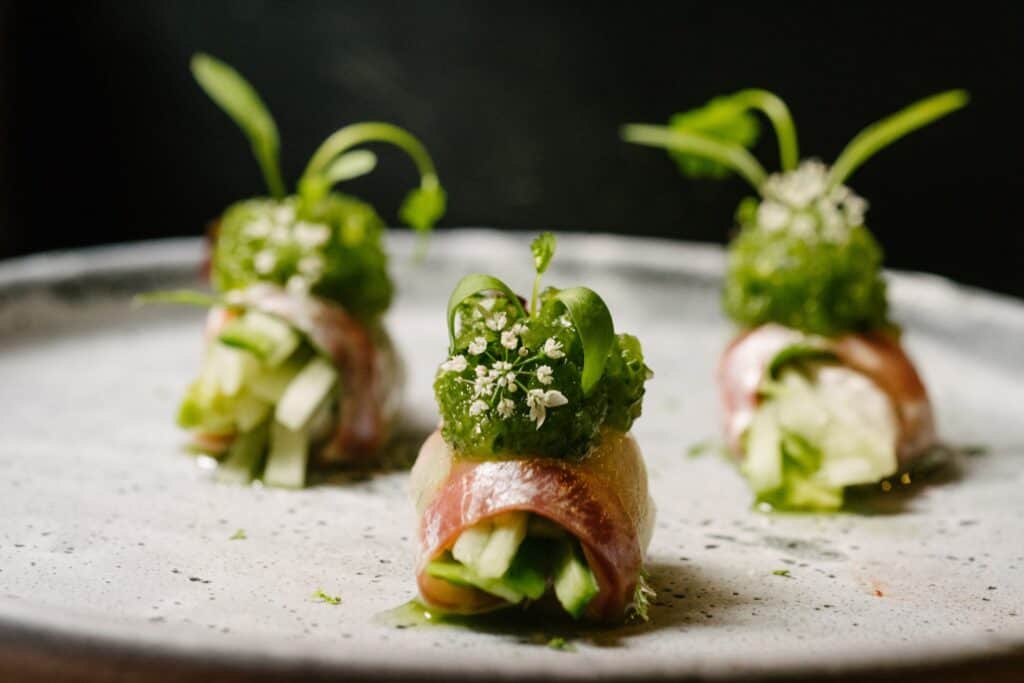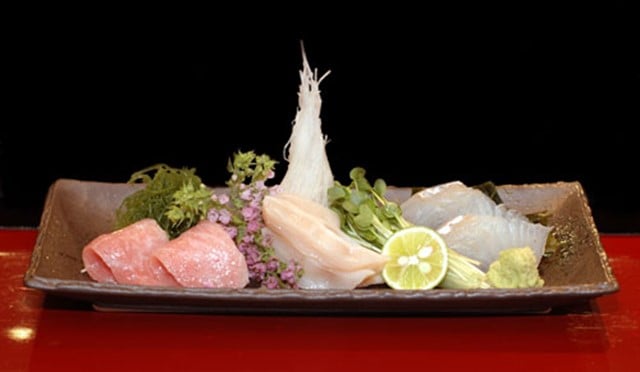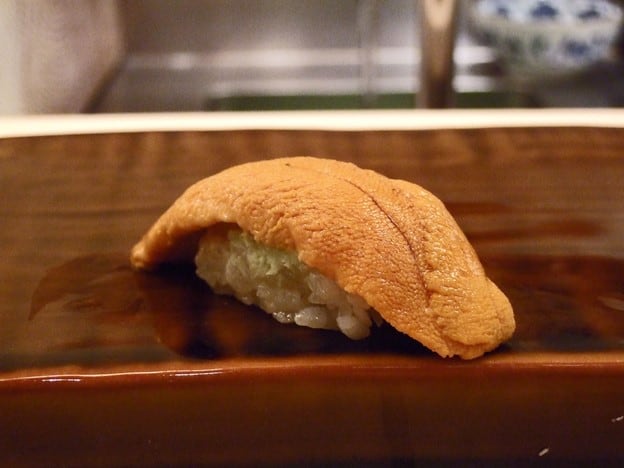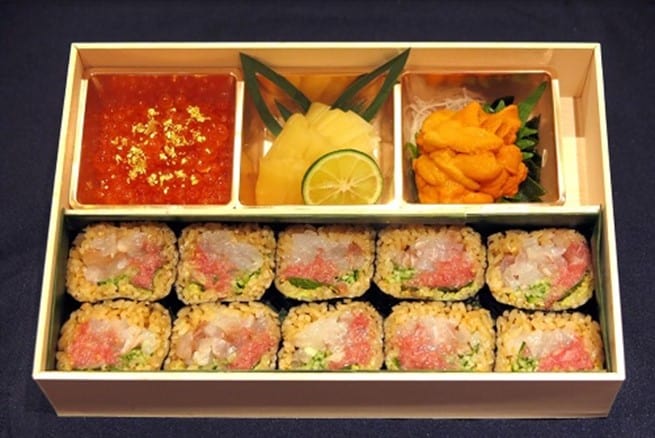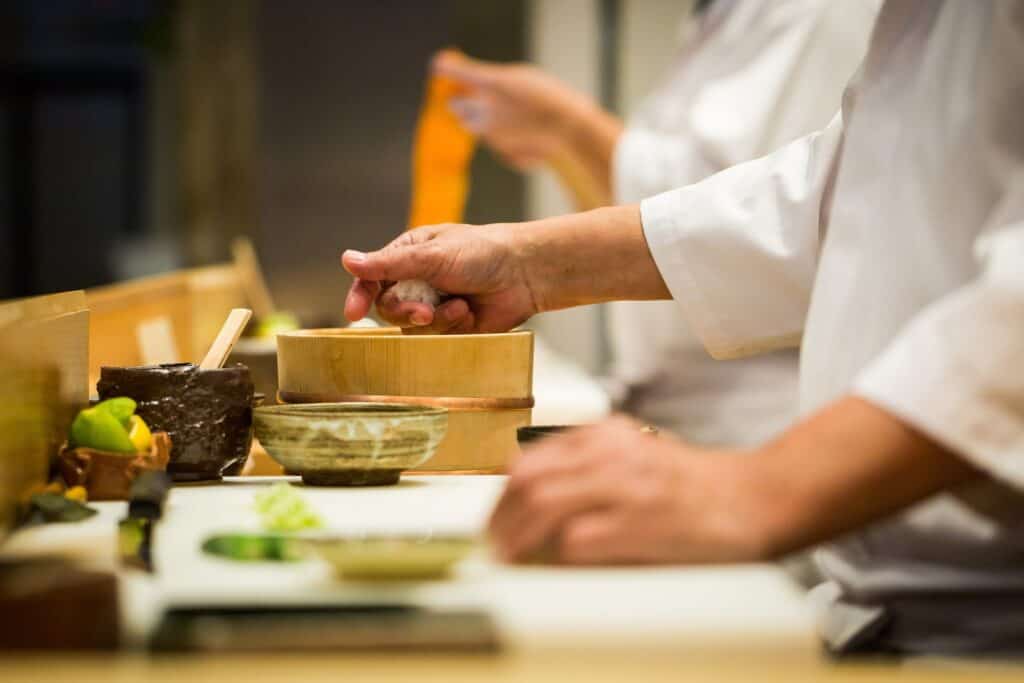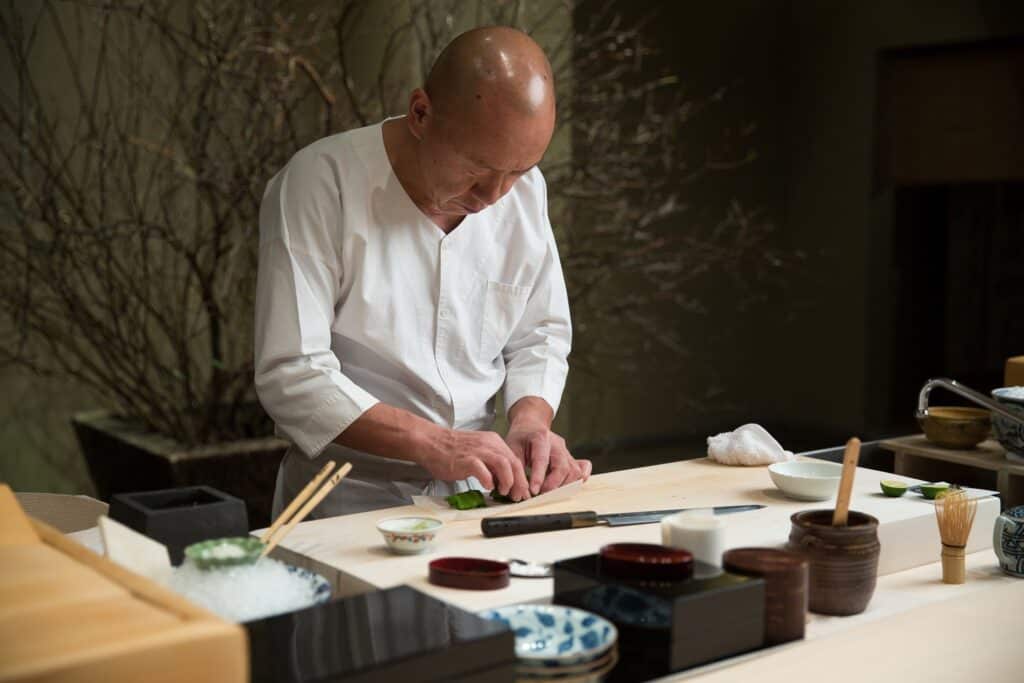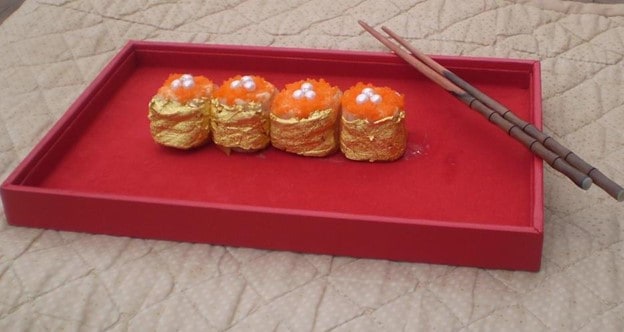Sushi has a long and treasured history in Japan, believed to go back to the 2nd century. Originally, it was created as a practicality, to preserve valuable fish using vinegar and salt curing, allowing cured fish to be served for up to a year later. The rice used to store the fish would then be thrown out (the word “sushi” actually means “sour rice”).
In the 19th century, Hanaya Yoshi turned this antique culinary method into a showstopping new luxury cuisine. From him, the modern extravagance of sushi can be traced to today’s most decadent restaurants. Continue reading to learn about the most expensive sushi in the world, including the restaurants and chefs that prepare and serve it.
- Naoe
- O Ya
- Kurumazushi Restaurant
- Urasawa
- Sushi Ginza Onodera
- Sushi Hashiri
- Masa Restaurant
- Golden Sushi
Location: Miami, Florida
Specialty: Sandfish and monkfish liver

photo source: Flickr
Naoe Miami is a restaurant awarded five stars by the Forbes Travel Guide, as well as being listed in one of the top 40 restaurants in the United States in 2019. Chef Kevin Cory serves a chef’s choice omakase menu with an upper limit of 16 guests per night.
The charge for this meal is $280 per person, plus a 20% sale and service tax. Some of the chef’s specialties include a whole Sandfish garnished with roe, lobster with golden ring octopus, and monkfish liver.
Did you know?
Cory’s family has owned a soy sauce brewery in Oono, Japan since 1825. The traditionally brewed and stored Shoyu soy sauce is well-known throughout the world as “Oonu-Shoyu.” Though less well-known in the states, Japanese chefs know that different regions produce slightly different flavors of soy sauces. The soy sauce from this region of Kanazawa City has a deeper and sweeter flavor than the soy sauces from the Kansai and Kanto regions.
Location: Boston, Massachusetts and Mexico City, Mexico
Specialty: Specialty nigiri

photo source: Boston Chefs
Chefs Tim and Nancy Cushman bring Japanese freshness and hospitality to Boston and Mexico City with their O Ya dining experience. The Omakase menu is a 20-course meal that includes nigiri and sashimi combinations, including seasonal cooked favorites. The meal costs $250 per person, plus $150 per person for specialty sake pairings, if desired.
Did you know?
Tim and Nancy Cushman founded Cushman Concepts to offer their decades of cooking expertise to a host of restaurants around the world. They include O Ya, which opened in 2007 and specializes in pairing luxury sushi and sashimi preparations with Japanese whiskey and sake.
Location: New York, New York
Specialty: Sashimi

photo source: Kurumazushi
The Kurumazushi Restaurant has been serving specialties since 1978 when Mr. Uezu was recruited to help create a new sushi bar after the Restaurant Saito burned down. The result is this restaurant, which is designed after traditional sushi bars, modeled after the dining experiences Uezu created during his apprenticeship at the restaurant’s original location in the Shinbashi district in Japan.
Meals at the Kurumazushi Restaurant can be reserved in a special washitsu room for a luxury antique (and best of all, private) dining experience. The meal costs $300 per person.
Did you know?
The meals at the Kurumazushi Restaurant start at $150 and include 9 sushi pieces and a specialty roll. The top $300 meal includes assorted fish and rice, the chef’s choice of sushi and sashimi, all topped off with specialty ice cream.
Location: Beverly Hills, California
Specialty: Marinated toro, caviar, uni

photo source: Flickr
Urasawa is a specialty sushi restaurant in Beverly Hills, California. Their sushi course costs $395 per person and includes such delicacies as squid nigiri, giant clam, sake-steamed abalone, kosode sushi, uni, tuna belly, and Shima aji.
Urasawa is built on the Ginza Sushi-ko model, which was a sushi bar owned by the legendary Masa Takayama that he took with him to New York (we’ll be talking about him again later). His sous chef was Hiroyuki Urasawa, who opened this restaurant using what he learned from his master.
Did you know?
The specialties at Urasawa include marinated tuna belly (or toro), sea urchin, gold-dusted caviar, and more.
Location: Midtown, New York
Specialty: Tsunami and sushi omakase

photo source: Citi Tour NY
Sushi Ginza Onodera in Midtown, New York provides an extensive menu that includes a $200 lunch meal and a $450 dinner meal, plus any desired add-ons. The meal includes 8 appetizers, 9 seasonal nigiri, a homemade tamago omelet, miso soup, and a specialty dessert.
Add-ons include Miyazaki beef nigiri with uni and caviar, golden eye snapper, and a sea urchin hand-roll, each $20 to $45 extra.
Did you know?
The chefs at Sushi Ginza Onodera make sushi in the Edomae style, which is based on the Edo methods of ancient Tokyo. This process includes aging and preserving the fish to make them more flavorsome and textured by marinating them in soy sauce broth, curing them in kelp and salt, and more.
Location: San Francisco, California
Specialty: Edomae sushi

photo source: Sushi Hashiri
The Michelin-starred Sushi Hashiri in San Francisco, California has several meal options, including a 9-course Kaiseki & Sushi meal for $250 and a 5-course meal for $200. The restaurant’s crowning achievement though is its Hashiri Omakase at Chef’s Table menu, which costs $500 and requires 2 weeks’ advanced notice to order.
The meal is served in a private room by a private sushi chef with a range of Kaiseki and Edomae sushi. Kaiseki is a tray of food served before matcha while Edomae is an antique sushi tradition that includes curing and preserving the fish first in the Edo style.
Did you know?
The Hashiri Omakase at Chef’s Table meal at Sushi Hashiri is always served with Kokuryu Ryu Fukui Sake, which by itself costs $250 per bottle.
Location: New York, New York
Specialty: Wagyu Beef Tataki

photo source: Masa NYC
Masa in New York City is well-known as one of the most expensive restaurants in the United States. Chef Masayoshi Takayama’s expertise in sushi preparations goes back to his family’s history in the Tochigi Prefecture in Japan. The chef went from delivery boy to caterer to master chef and now offers several meals that could be on this list separately, including an Omakase menu that costs $650 per person.
However, the real treasure at Masa is the Hinoki Counter Experience, which costs $800 per person. Buyers of this meal get to sit at the antique sushi counter and enjoy a legacy of Japanese cuisine, including sushi served with Wagyu Ohmi Beef Tataki, A5 quality, topped with shaved truffle.
Did you know?
You can also order Sake at Masa, which is $200 per bottle. Unlike some of the more Americanized restaurants on this list, Masa does not include gratuities in the price of the menu. In fact, the restaurant does not even accept tips if given, in keeping with the Japanese custom to serve without receiving gratuities. They consider hospitality a cultural priority, not an add-on.
Location: Philippines
Specialty: Gemstone garnishes

photo source: Ako Sushi
The most expensive sushi is the Golden Sushi. This sushi is not a meal at a restaurant but the artisan creations by a specialty sushi freelancer named Chef Angelito Araneta Jr. He’s based in the Philippines and has become known as the “Carat Chef” because of this sushi.
His Golden Sushi creations cost $1,978 per person and were named by the Guinness World Records as the world’s most expensive sushi. These nigiri rolls are made from pink salmon sourced from Norway and foie gras and are topped with Palawan pearls, 20-carat African diamonds, and edible 24-carat gold leaf.
Did you know?
Palawan Pearls from the Philippines are sometimes known as Pearls of the Orient Sea. They are sourced from the Palawan province, which is an archipelago between the Sulu and South China Seas, to which the Carat Chef has direct access from his operation in the Philippines. He doesn’t serve these rolls at a restaurant – you have to call and order it privately for him to come to you and prepare this extravagant meal.
The Takeaway
The most expensive sushi restaurants in the world specialize in “omakase” menus, which are made in a traditional Japanese style of cooking in restaurants. The word means “I’ll leave it up to you” in reference to the chefs choosing the menu for the patrons on a seasonal basis. Most of the sushi on this list includes a certain number of specialty sushi and sashimi pieces, a style that the Michelin Guide calls one of the world’s most intimidating … and revered. To partake of this cuisine at the highest level, which is the envy of chefs and patrons around the world, you’ll have to shell out hundreds. But at least you won’t have to leave a tip!


